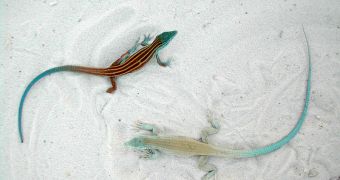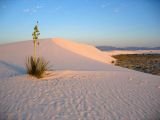In a new study conducted on lizard populations that lived at White Sands, New Mexico, it was determined that various species employed different evolutionary paths to reach the same outcome. When it comes to camouflage, there is no strict recipe, experts believe, as each type of lizard tends to evolve its genes in different ways. The Sands offer an ideal place to study gene flow and natural selection, as it contains both bright and dark patches of soil, each of them inhabited by different lizard species.
The new work was conducted by researchers at the University of Idaho, who were led by expert Erica Rosenblum. With the help of a grant from the US National Science Foundation (NSF), the group was able to make important findings, which were then reported in the December 28 issue of the respected journal Proceedings of the National Academy of Sciences (PNAS). Rosenblum determined that, in the three species of lizards involved in the study, the gene encoding the melanocortin-1 receptor (Mc1r) had suffered mutations. This resulted invariably in white skin.
But what's really interesting is the fact that natural selection arrived at the same outcome by modifying various aspects of Mc1r. For example, in one species, the receptor was bound at the correct location in the cells, but could not transmit a signal, whereas a second species had a working receptor, but placed in a wrong position. The end-result was the same, but each of the species suffered different lines of mutations to get there.
“The mutations we observed resulted in two distinct changes in how the Mc1 receptor functioned. Mc1r acts like a light switch for melanin, so even though the way the signaling is disrupted is different, outwardly we see the same result: light-skinned lizards,” Rosenblum says.
“There is preliminary evidence that suggests the genes involved in adaptation can also affect speciation. Changes in melanin affect coloration on the top of the body, which predators see, and also the sides of the body, which other lizards use to decide who to mate with. Therefore both natural selection and [mate] selection appear to play a role in this system,” she adds. The group also reveals that the White Sands is one of the few places in the world with the capabilities to foster fast speciation, which is the formation of a new species in only a few thousand years.
This knowledge is very important in the context of habitat preservations, and also for protecting endangered species from the effects of human activities and global warming. Rosenblum believes that, as soon as scientists learn how speciation takes place, and what are its driving factors, it would become a lot easier to devise efficient plans to guide this process.

 14 DAY TRIAL //
14 DAY TRIAL // 
